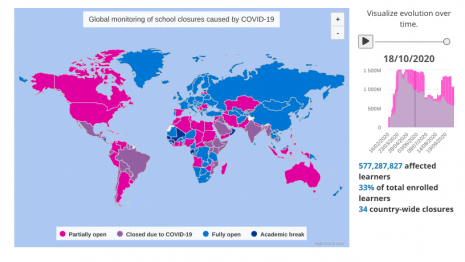Not just re-building but re-imagining
The corona virus pandemic brought on it’s fair share of curve balls and challenges, and affected both individuals – personally and professionally – and impacted organisations across health, education and finance sectors.
According to UNESCO as of October 2020, around 1.3 billion children are still affected by school closure, making this pandemic the longest period children have been out of school. Many questioned whether SDG4 was on track prior to the pandemic, how many more are asking whether it’s achievable at all. Ensuring inclusive and equitable quality education that promotes lifelong learning opportunities will be more essential than ever before as countries start to re-build. Re-building will be about building back better; strengthening and supporting systems to ensure that no child is left behind; rather than re-starting previous failing systems wholesale.
The importance of building back better was stressed by UNICEF. “The world has an unprecedented opportunity to put in place the solutions that respond effectively to COVID-19 now, but that also strengthen the systems to better respond to future crises.” In some senses, COVID-19 has created an environment to reconsider the gaps and challenges in the education sector and implement programmes that are effective both now and when education systems re-open.

Yet before thinking about re-building, educators needed to implement responses to mitigate the immediate impact of this unexpected interruption to education. During the pandemic, Governments, educators and teachers worked together to ensure learning continued for children via a range of remote learning resources and technologies.
Education in remote areas
Specifically designed for low infrastructure and limited connectivity environments; Bridge’s resources have leveraged multiple touch points and technologies already used in our communities. The programming includes mobile interactive quizzes, audio lessons and virtual classrooms all based upon technologies and channels that are already prevalent and widely used in communities. Designed to use minimum amounts of data; and based upon accessible functionality children – and parents – are accessing resources through channels that are already integrated into their school management and engagement systems and processes.

And for communities that are still struggling to access the remote learning resources, schools and governments are constantly coming up with alternative ways to reach undeserved populations. A good example of this is in Bridge Kenya where teachers are helping to print out learning materials for families; or downloading materials and leaving them with cybercafe partners for parents to photocopy – increasing accessibility and affordability. Making WhatsApp quizzes available via SMS for parents who are unable to access the platform.
Technology has proven to be an essential tool in facilitating remote learning for millions of children. Bridge has always been a strong advocate of technology as a tool to help improve outcomes and systems. It has underpinned some of the innovations that have been fundamental in transforming and improving teaching, performance and accountability. As schools and systems re-emerge from the pandemic, the question now is what will the role of technology be as we attempt to build back better.
What exactly does building back better look like?
What exactly does building back better look like? According to the Global Partnership for Education (GPE)
“With the right kind of investments, the crisis provides an opportunity to re-imagine education, including blended learning models which, with the right investments in the combination of educator-led instruction and technology”

In addition the GPE stresses that “The pandemic providing a ‘once in a generation’ opportunity to ensure all children and young people access learning anywhere, any time. A final opportunity to “Educate the recovery” is the public investment programs that will come on stream to create employment and reboot economic activity. To benefit education, these programs could include training and upskilling programs. This could include training and workforce development programs for education professionals to provide additional support around inclusion and well-being for the most vulnerable children, especially girls, and lay the foundation for a transformation of the education workforce.”
Delivering re-imagined distance education services
At Bridge we know that, used effectively, education technology enhances not only learning outcomes but transparency and accountability. As the education community considers how to ‘build back better’ we should learn not only from innovations that have been implemented during the pandemic but programmes that are delivering effectively using some of the technologies and approaches that could become more widespread. There is no point reopening existing failing systems. We should use this moment to rebuild those systems so they deliver more effectively and enables an environment that fosters learning for every child
